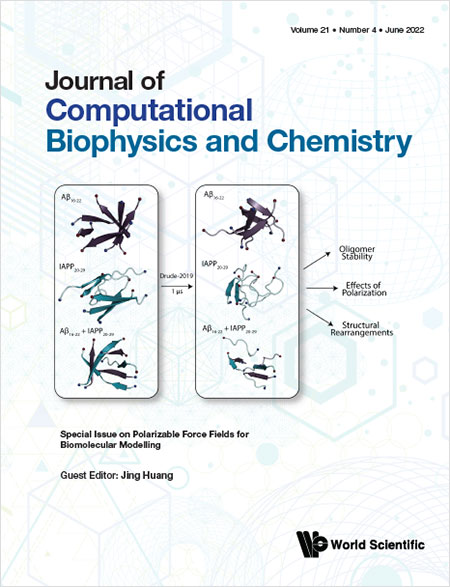System Upgrade on Tue, May 28th, 2024 at 2am (EDT)
Existing users will be able to log into the site and access content. However, E-commerce and registration of new users may not be available for up to 12 hours.For online purchase, please visit us again. Contact us at customercare@wspc.com for any enquiries.
Volume 21, Issue 04 (June 2022)
Special Issue on Polarizable Force Fields for Biomolecular ModellingGuest Editor: Jing Huang
Editorial: Special Issue on Polarizable Force Fields for Biomolecular Modelling
- Pages:389–390
Conformational Flexibilities and Solvation Properties of Insulin in Aromatic Amino Acid Solutions: A Molecular Dynamics Study Using CHARMM Drude Polarizable Model
- Pages:391–404
https://doi.org/10.1142/S2737416521420011

We performed atomistic molecular dynamics simulations using CHARMM Drude polarizable force field to investigate the conformational properties of insulin monomer in 2M phe, tyr, trp solutions and in pure aqueous solution. Although insulins native folded form was found intact in all the solutions, a little more flexibility and less compactness in the phe solution than in the tyr/trp solutions was noticed. Our calculations revealed that all the free aromatic amino acids interact with insulin residues primarily through different aromatic interactions like; cation-π, anion-π, and π–π stacking, and partly through hydrogen-bonded interactions. Among the three, while trp was prone to interact through cation-π interactions, phe and tyr interacted through π–π stacking with the protein. Our study suggests that the variation of amino acid compositions in protein segments is likely to play a role in the stability of a protein in the aqueous aromatic amino acid solutions.
Testing and Optimizing the Drude Polarizable Force Field for Blocked Amino Acids Based on High-Level Quantum-Mechanical Energy Surfaces
- Pages:405–413
https://doi.org/10.1142/S2737416521420023

- The CHARMM Drude polarizable force field was tested based on high-level quantum-mechanical calculations using all low lying energy minima occurring in all 15 neutral blocked amino acids.
- Several bonded terms were reparameterized to improve the agreement between the two energy surfaces.
Recent Developments in Polarizable Molecular Dynamics Simulations of Electrolyte Solutions
- Pages:415–429
https://doi.org/10.1142/S2737416521420035

- Polarizable molecular dynamics simulations are a fast progressing field in the scientific research of ionic liquids.
- This review highlights the recent developments in intermolecular interactions of induced dipoles and introduces the most used force fields in the past and future.
High-Order Ab Initio Valence Force Field with Chemical Pattern-Based Parameter Assignment
- Pages:431–447
https://doi.org/10.1142/S2737416521420047

Bonded interactions are fundamental ingredients of molecular mechanics force fields because they directly determine the local structure of a molecule. In this work, we parametrize the advanced bonded energy functionals that consider the vibrational anharmonicity, the coupling effects, and the out-of-plane bending for sp2-hybridized atoms. It is expected that these models can describe the spectroscopic properties and overall structures of a molecule more accurately when they are used with polarizable AMOEBA-based force fields.
Impact of Electronic Polarization on Preformed, β-Strand Rich Homogenous and Heterogeneous Amyloid Oligomers
- Pages:449–460
https://doi.org/10.1142/S2737416521420059

Polarizable molecular dynamics simulations were performed with preformed, homogenous and heterogenous oligomers comprised of amyloidogenic Aβ6-22 and IAPP20-29 fragments using the Drude oscillator model to probe the impact of electronic polarization on structural morphology and oligomer stability. Structural rearrangement was observed for all oligomers, and differences in stability were observed as a function of residue microenvironment in homogenous vs. heterogeneous oligomers. This work highlights the importance of polarizability in the structural morphologies of amyloid oligomers.
Accurate Modeling of RNA Hairpins Through the Explicit Treatment of Electronic Polarizability with the Classical Drude Oscillator Force Field
- Pages:461–471
https://doi.org/10.1142/S2737416521420060

The presence of polarizability in the Drude force field (FF) improves the stability of RNA hairpin structures over the CHARMM36 additive FF by conserving non-canonical hydrogen bonds in the loop regions. Notably, dipole moments of some bases in the loop region show variations depending on their participation in hydrogen bonding when simulated using the polarizable FF. In addition, larger variations in the ion distribution around the RNA hairpins occur with the using the polarizable versus the CHARMM36 additive FF.
Advances in Molecular Modeling of Ion-Protein Interaction Systems Towards Accurate Electrostatics: Methods and Applications
- Pages:473–483
https://doi.org/10.1142/S2737416521420072

Recent Development and Applications of the ABEEM/MM Polarizable Force Field
- Pages:485–498
https://doi.org/10.1142/S2737416521420084

The development and applications of the ABEEM/MM fluctuating charge polarizable force field are reviewed.
We focus on the applications of ABEEM/MM in pure water, ion-containing systems, small molecules, biomolecules, etc.
The performance of the ABEEM/MM is generally better than those of the non-polarizable force fields.

